2006 CHEVROLET EXPRESS PASSANGER child seat
[x] Cancel search: child seatPage 62 of 406
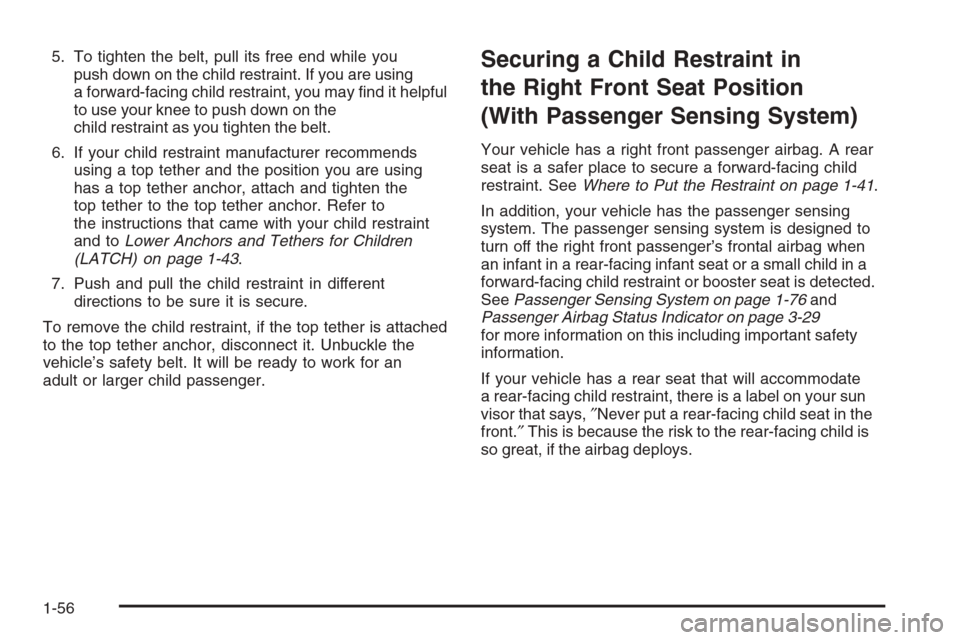
5. To tighten the belt, pull its free end while you
push down on the child restraint. If you are using
a forward-facing child restraint, you may find it helpful
to use your knee to push down on the
child restraint as you tighten the belt.
6. If your child restraint manufacturer recommends
using a top tether and the position you are using
has a top tether anchor, attach and tighten the
top tether to the top tether anchor. Refer to
the instructions that came with your child restraint
and toLower Anchors and Tethers for Children
(LATCH) on page 1-43.
7. Push and pull the child restraint in different
directions to be sure it is secure.
To remove the child restraint, if the top tether is attached
to the top tether anchor, disconnect it. Unbuckle the
vehicle’s safety belt. It will be ready to work for an
adult or larger child passenger.Securing a Child Restraint in
the Right Front Seat Position
(With Passenger Sensing System)
Your vehicle has a right front passenger airbag. A rear
seat is a safer place to secure a forward-facing child
restraint. SeeWhere to Put the Restraint on page 1-41.
In addition, your vehicle has the passenger sensing
system. The passenger sensing system is designed to
turn off the right front passenger’s frontal airbag when
an infant in a rear-facing infant seat or a small child in a
forward-facing child restraint or booster seat is detected.
SeePassenger Sensing System on page 1-76and
Passenger Airbag Status Indicator on page 3-29
for more information on this including important safety
information.
If your vehicle has a rear seat that will accommodate
a rear-facing child restraint, there is a label on your sun
visor that says,″Never put a rear-facing child seat in the
front.″This is because the risk to the rear-facing child is
so great, if the airbag deploys.
1-56
Page 63 of 406
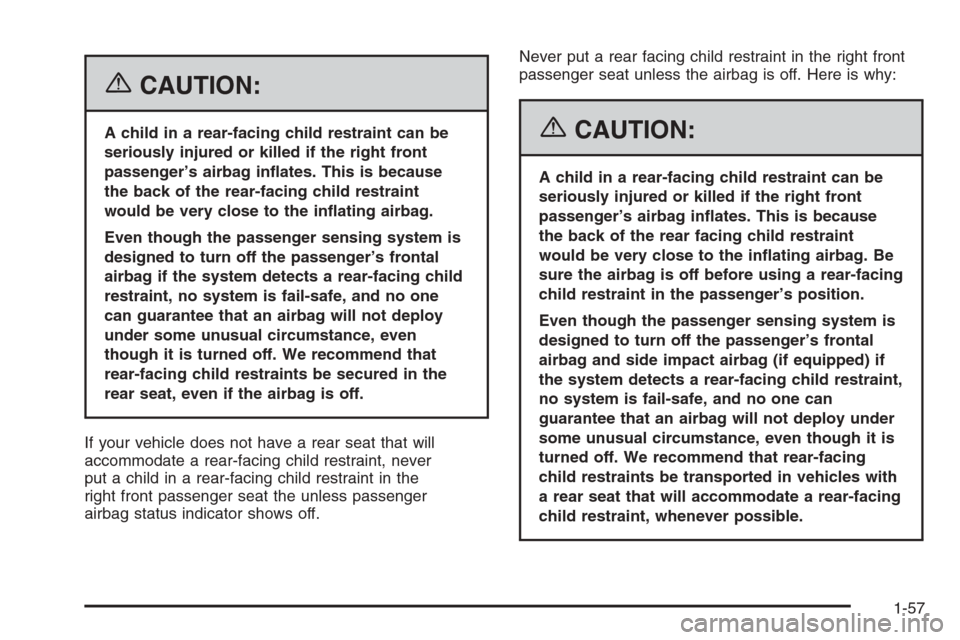
{CAUTION:
A child in a rear-facing child restraint can be
seriously injured or killed if the right front
passenger’s airbag in�ates. This is because
the back of the rear-facing child restraint
would be very close to the in�ating airbag.
Even though the passenger sensing system is
designed to turn off the passenger’s frontal
airbag if the system detects a rear-facing child
restraint, no system is fail-safe, and no one
can guarantee that an airbag will not deploy
under some unusual circumstance, even
though it is turned off. We recommend that
rear-facing child restraints be secured in the
rear seat, even if the airbag is off.
If your vehicle does not have a rear seat that will
accommodate a rear-facing child restraint, never
put a child in a rear-facing child restraint in the
right front passenger seat the unless passenger
airbag status indicator shows off.Never put a rear facing child restraint in the right front
passenger seat unless the airbag is off. Here is why:{CAUTION:
A child in a rear-facing child restraint can be
seriously injured or killed if the right front
passenger’s airbag in�ates. This is because
the back of the rear facing child restraint
would be very close to the in�ating airbag. Be
sure the airbag is off before using a rear-facing
child restraint in the passenger’s position.
Even though the passenger sensing system is
designed to turn off the passenger’s frontal
airbag and side impact airbag (if equipped) if
the system detects a rear-facing child restraint,
no system is fail-safe, and no one can
guarantee that an airbag will not deploy under
some unusual circumstance, even though it is
turned off. We recommend that rear-facing
child restraints be transported in vehicles with
a rear seat that will accommodate a rear-facing
child restraint, whenever possible.
1-57
Page 64 of 406
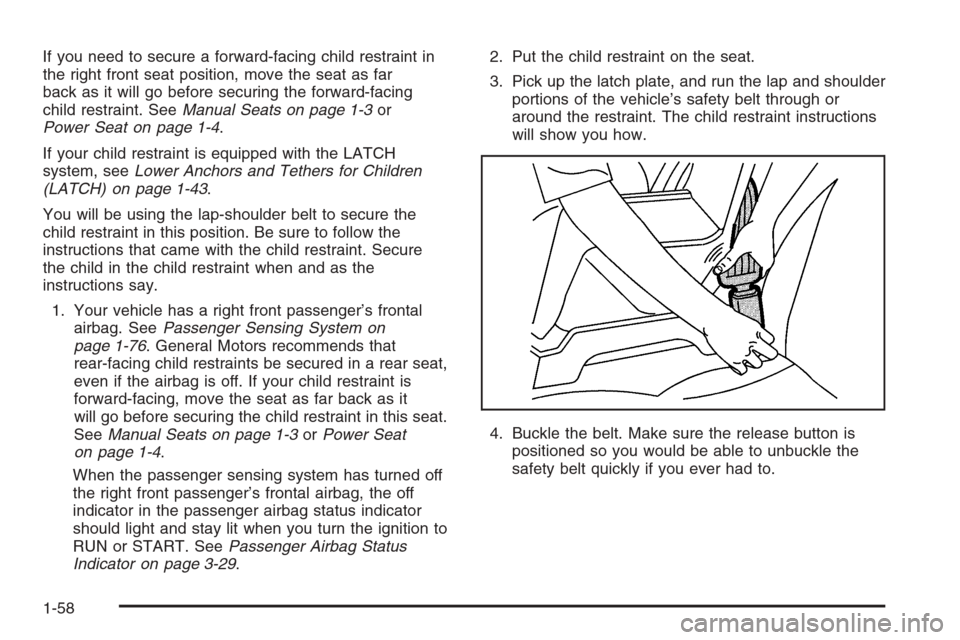
If you need to secure a forward-facing child restraint in
the right front seat position, move the seat as far
back as it will go before securing the forward-facing
child restraint. SeeManual Seats on page 1-3or
Power Seat on page 1-4.
If your child restraint is equipped with the LATCH
system, seeLower Anchors and Tethers for Children
(LATCH) on page 1-43.
You will be using the lap-shoulder belt to secure the
child restraint in this position. Be sure to follow the
instructions that came with the child restraint. Secure
the child in the child restraint when and as the
instructions say.
1. Your vehicle has a right front passenger’s frontal
airbag. SeePassenger Sensing System on
page 1-76. General Motors recommends that
rear-facing child restraints be secured in a rear seat,
even if the airbag is off. If your child restraint is
forward-facing, move the seat as far back as it
will go before securing the child restraint in this seat.
SeeManual Seats on page 1-3orPower Seat
on page 1-4.
When the passenger sensing system has turned off
the right front passenger’s frontal airbag, the off
indicator in the passenger airbag status indicator
should light and stay lit when you turn the ignition to
RUN or START. SeePassenger Airbag Status
Indicator on page 3-29.2. Put the child restraint on the seat.
3. Pick up the latch plate, and run the lap and shoulder
portions of the vehicle’s safety belt through or
around the restraint. The child restraint instructions
will show you how.
4. Buckle the belt. Make sure the release button is
positioned so you would be able to unbuckle the
safety belt quickly if you ever had to.
1-58
Page 66 of 406

7. If your child restraint manufacturer recommends
using a top tether and the position you are using
has a top tether anchor, attach and tighten the
top tether to the top tether anchor. Refer to the
instructions that came with the child restraint and to
Lower Anchors and Tethers for Children (LATCH) on
page 1-43.
8. Push and pull the child restraint in different
directions to be sure it is secure.
9. If the airbag is off, the off indicator on the instrument
panel will be lit and stay lit when the key is turned
to RUN or START.
If a child restraint has been installed and the on
indicator is lit, turn the vehicle off. Remove the child
restraint from the vehicle and reinstall the child restraint.
If after reinstalling the child restraint and restarting the
vehicle, the on indicator is still lit, check to make sure
that the vehicle’s seatback is not pressing the child
restraint into the seat cushion. If this happens, slightly
recline the vehicle’s seatback and adjust the seat
cushion if possible. Also make sure the child restraint is
not trapped under the vehicle head restraint. If this
happens, adjust the head restraint.If the on indicator is still lit, secure the child in the child
restraint in a rear seat position in the vehicle and
check with your dealer.
To remove the child restraint, if the top tether is attached
to the top tether anchor, disconnect it. Unbuckle the
vehicle’s safety belt and let it go back all the way.
The safety belt will move freely again and be ready to
work for an adult or larger child passenger.
Securing a Child Restraint in
the Right Front Seat Position
(With Airbag Off Switch)
Your vehicle has a right front passenger airbag. There
is a switch on the instrument panel that you can use
to turn off the right front passenger’s frontal airbag.
SeeAirbag Off Switch on page 1-73for more on this,
including important safety information.
1-60
Page 67 of 406
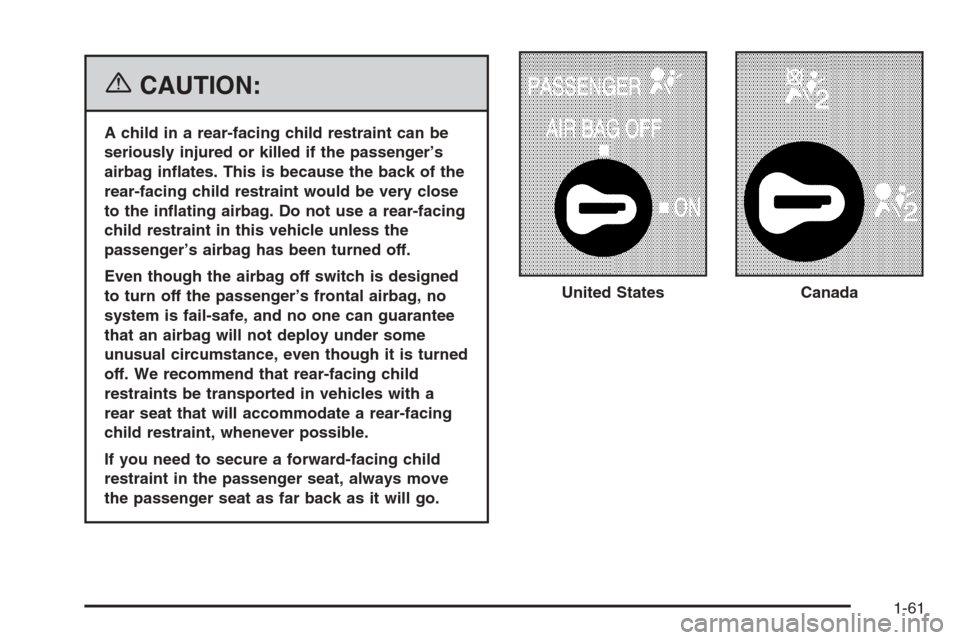
{CAUTION:
A child in a rear-facing child restraint can be
seriously injured or killed if the passenger’s
airbag in�ates. This is because the back of the
rear-facing child restraint would be very close
to the in�ating airbag. Do not use a rear-facing
child restraint in this vehicle unless the
passenger’s airbag has been turned off.
Even though the airbag off switch is designed
to turn off the passenger’s frontal airbag, no
system is fail-safe, and no one can guarantee
that an airbag will not deploy under some
unusual circumstance, even though it is turned
off. We recommend that rear-facing child
restraints be transported in vehicles with a
rear seat that will accommodate a rear-facing
child restraint, whenever possible.
If you need to secure a forward-facing child
restraint in the passenger seat, always move
the passenger seat as far back as it will go.United States
Canada
1-61
Page 68 of 406
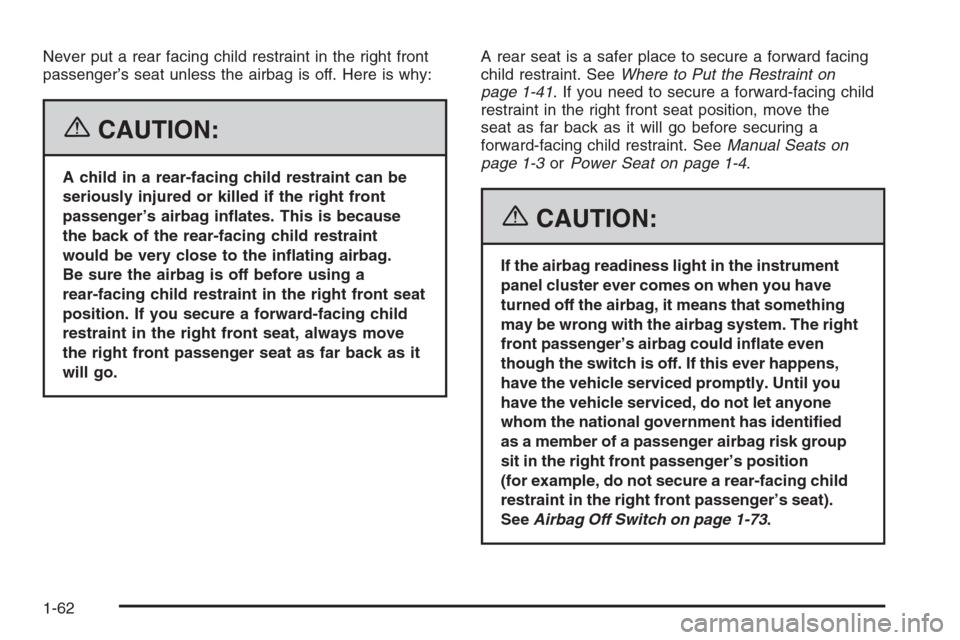
Never put a rear facing child restraint in the right front
passenger’s seat unless the airbag is off. Here is why:
{CAUTION:
A child in a rear-facing child restraint can be
seriously injured or killed if the right front
passenger’s airbag in�ates. This is because
the back of the rear-facing child restraint
would be very close to the in�ating airbag.
Be sure the airbag is off before using a
rear-facing child restraint in the right front seat
position. If you secure a forward-facing child
restraint in the right front seat, always move
the right front passenger seat as far back as it
will go.A rear seat is a safer place to secure a forward facing
child restraint. SeeWhere to Put the Restraint on
page 1-41. If you need to secure a forward-facing child
restraint in the right front seat position, move the
seat as far back as it will go before securing a
forward-facing child restraint. SeeManual Seats on
page 1-3orPower Seat on page 1-4.
{CAUTION:
If the airbag readiness light in the instrument
panel cluster ever comes on when you have
turned off the airbag, it means that something
may be wrong with the airbag system. The right
front passenger’s airbag could in�ate even
though the switch is off. If this ever happens,
have the vehicle serviced promptly. Until you
have the vehicle serviced, do not let anyone
whom the national government has identi�ed
as a member of a passenger airbag risk group
sit in the right front passenger’s position
(for example, do not secure a rear-facing child
restraint in the right front passenger’s seat).
SeeAirbag Off Switch on page 1-73.
1-62
Page 69 of 406
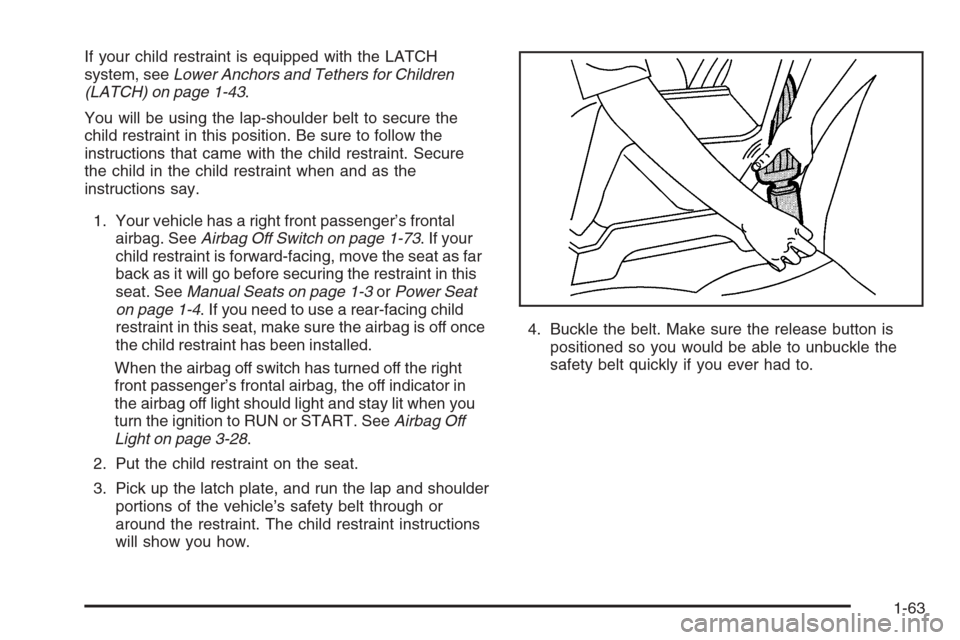
If your child restraint is equipped with the LATCH
system, seeLower Anchors and Tethers for Children
(LATCH) on page 1-43.
You will be using the lap-shoulder belt to secure the
child restraint in this position. Be sure to follow the
instructions that came with the child restraint. Secure
the child in the child restraint when and as the
instructions say.
1. Your vehicle has a right front passenger’s frontal
airbag. SeeAirbag Off Switch on page 1-73. If your
child restraint is forward-facing, move the seat as far
back as it will go before securing the restraint in this
seat. SeeManual Seats on page 1-3orPower Seat
on page 1-4. If you need to use a rear-facing child
restraint in this seat, make sure the airbag is off once
the child restraint has been installed.
When the airbag off switch has turned off the right
front passenger’s frontal airbag, the off indicator in
the airbag off light should light and stay lit when you
turn the ignition to RUN or START. SeeAirbag Off
Light on page 3-28.
2. Put the child restraint on the seat.
3. Pick up the latch plate, and run the lap and shoulder
portions of the vehicle’s safety belt through or
around the restraint. The child restraint instructions
will show you how.4. Buckle the belt. Make sure the release button is
positioned so you would be able to unbuckle the
safety belt quickly if you ever had to.
1-63
Page 79 of 406
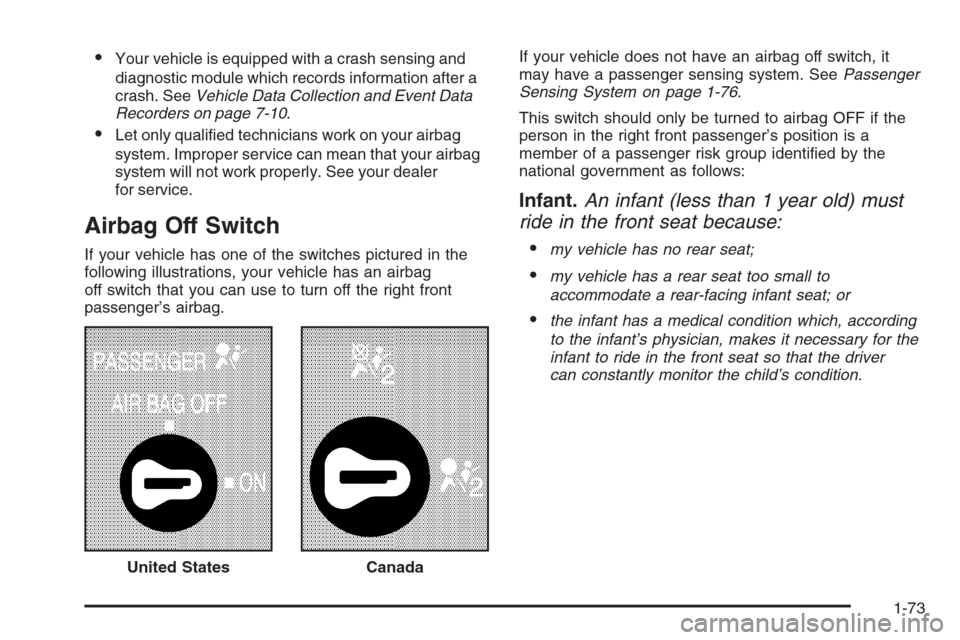
•Your vehicle is equipped with a crash sensing and
diagnostic module which records information after a
crash. SeeVehicle Data Collection and Event Data
Recorders on page 7-10.
•Let only qualified technicians work on your airbag
system. Improper service can mean that your airbag
system will not work properly. See your dealer
for service.
Airbag Off Switch
If your vehicle has one of the switches pictured in the
following illustrations, your vehicle has an airbag
off switch that you can use to turn off the right front
passenger’s airbag.If your vehicle does not have an airbag off switch, it
may have a passenger sensing system. SeePassenger
Sensing System on page 1-76.
This switch should only be turned to airbag OFF if the
person in the right front passenger’s position is a
member of a passenger risk group identified by the
national government as follows:
Infant.An infant (less than 1 year old) must
ride in the front seat because:
•
my vehicle has no rear seat;
•my vehicle has a rear seat too small to
accommodate a rear-facing infant seat; or
•the infant has a medical condition which, according
to the infant’s physician, makes it necessary for the
infant to ride in the front seat so that the driver
can constantly monitor the child’s condition.
United States
Canada
1-73